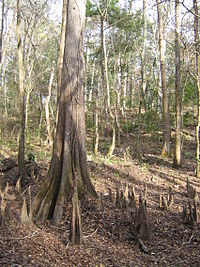- Cypress knee
-
In the biology of trees, a cypress knee is a distinctive structure in a root of a cypress tree of any of various species of the subfamily Taxodioideae. Their function is unknown, but they are generally seen in swamps. Some scientists have thought they may help in providing oxygen to the tree and assist in anchoring the tree in the soft, muddy soil.
Knees are woody projections sent above the normal water level, roughly horizontally from the roots, with a near-right-angle bend taking them roughly vertically downward into soil, usually passing through water first. One early assumption of their function was that they provided oxygen to the roots that grow in the low dissolved oxygen (DO) waters typical of a swamp (see also mangroves, which have similar adaptations), acting as pneumatophores. However, there is little actual evidence for this; in fact, swamp-dwelling specimens whose knees are removed continue to thrive, and laboratory tests demonstrate that they are not effective at depleting oxygen in a sealed chamber. Despite the fact that there is no expert consensus on their role, the supposition that they are pneumatophores is repeated without note in several introductory botany textbooks.
Another more likely function is that of structural support and stabilization. Lowland or swamp-grown cypresses found in flooded or flood-prone areas tend to be buttressed and "kneed," as opposed to cypresses grown on higher ground which may grow with very little taper.
Trees that develop these "knees" include the following:
External links
- Christopher H. Briand. "Cypress Knees: An Enduring Enigma." Arnoldia. 2000-2001.Vol. 60(4). p. 19-20, 21-25. An extensive review of the published literature concerning cypress knees.
Categories:
Wikimedia Foundation. 2010.

